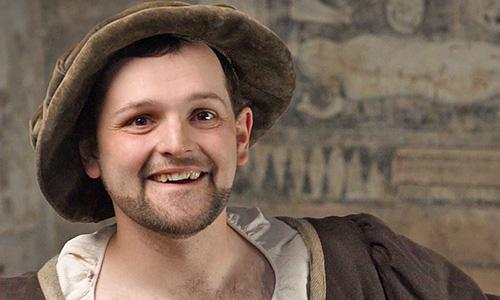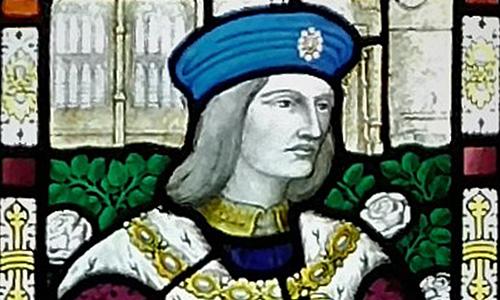Who was Hugh Clopton?
Hugh Clopton, the great benefactor of the Guild Chapel of the Holy Cross, had a house right across the road from the Chapel on the corner of Chapel Street and Chapel Lane. Hugh Clopton was the second son of John Clopton, a very wealthy local man who was a Master of the Guild in 1473 and 1480. Hugh was born in 1440 and grew up in Clopton House, a large mansion up on the Welcombe Hills overlooking Stratford-upon-Avon. The house has an interesting history but has been modified over the years and is now divided up into several modern private apartments and so cannot be visited by the public. It can be seen though from many of the footpaths crossing the Welcombe Hills.
His father’s property was to be inherited by Hugh’s elder brother Thomas, so Hugh had to make his own way in the world. In 1456 Hugh went to London and was apprenticed to a man called John Roo to learn to become a Mercer trading in wool and cloth. In 1457 John Roo died, but Hugh successfully completed his apprenticeship in 1463 with John Roo’s son-in-law, John Baker. Hugh Clopton became a very successful businessman dealing in wool and cloth which was sent out to the continent via London and Calais, which at that time still belonged to England.
Why is Hugh Clopton’s house called 'New Place'?
As a mercer, Hugh Clopton lived in the City of London but with his increasing wealth, he decided to build his own grand house in his home town of Stratford-upon-Avon. It is not known exactly when building work started, but it may well have been just before 1485 when he became a Master of the Guild of the Holy Cross in Stratford and so a date of 1483 is often given. The site that he chose was right next to the Guild Chapel and the Guildhall in one of the most important parts of the town.
There was already a house standing on the site, which was a grand old house, well over 100 years old, with a stone-tiled roof and stone foundations and so this had to be taken down. Some of the old stone foundations were used in building the new house, but Hugh must have wanted to make a clear statement to show off his wealth because his ‘Great House’, as he called it, was to be the largest dwelling house in Stratford and was larger than the building that it replaced. As there had been an older property on the site, the local people must have thought of the replacement building as Hugh Clopton’s new place because the name New Place stuck and it is still referred to as that nowadays, over 500 years later.
What was New Place like?
The site of Hugh Clopton’s house in Stratford-upon-Avon is now a garden and what we know about New Place comes mainly from an archaeological dig which took place between 2010 and 2015, following on from an earlier dig which had been carried out by James Orchard Halliwell from 1862 to 1863.
New Place consisted of a series of three main buildings on three sides of a courtyard. The main building was a large hall which was set back from the main road and faced onto the courtyard. On the opposite side of the courtyard was a two-storeyed building which faced west onto Chapel Street. This street facing building is believed to have included shops on the ground floor which were let to local crafts people and traders. Lead seals associated with the wool trade were found by archaeologists on this part of the site. The main entrance to the courtyard for more distinguished guests would have been through a gateway in this building.
Connecting the street-facing building and the main hall was a two-storey link building, or service range, running along Chapel Lane which had workrooms for things such as food preparation on the ground floor and a cellar for storage at the Chapel Street end. There was a narrow passageway running through this building connecting Chapel Lane to the courtyard, and this is the entrance that servants would have used. It would have been a far less grand entrance than that from Chapel Street, especially since at that time the street we now know as Chapel Lane had a stream running along it which was used for washing wool and could have been quite polluted at times.
At the time that New Place was built, Chapel Lane was called Walkers Lane as Walker was one of the names given to people who washed wool (they were also known as Fullers). It was also sometimes known as Dead Lane which may have referred to it being used to transport bodies to Holy Trinity graveyard following funeral services at the Guild Chapel. The modern name, Chapel Lane only came into use from around 1500 once the new Guild Chapel nave had been built. There is evidence that one of the workrooms in this service range was used for brewing beer which in those days was generally weaker in alcohol than nowadays and would have been drunk by people of all ages and at all times of the day. On the other side of the courtyard was a low wall separating New Place from the house next door. In the middle of the courtyard was New Place’s own well, which is the only part of the house to survive to the present day.
Hugh Clopton would have used the main hall to entertain his friends and guests in Stratford-upon-Avon and he may also have used it for business meetings associated with his visits to the town. His living apartments though would probably have been on the upper floor of the building running alongside Chapel Lane above the workrooms. Hugh Clopton’s New Place was therefore a very grand house as befitting a man of his status. Although Hugh Clopton’s New Place no longer exists, it is possible to get an idea of what it was like inside by visiting the Commandery in Worcester which was built around the same time and is very similar in structure.
What happened to New Place after Hugh Clopton died?
In 1492 Hugh’s elder brother, Thomas Clopton, died and since Thomas’ own son had died six years earlier, Hugh inherited the Clopton family estate and possessions. Surprisingly for a man of Hugh Clopton’s wealth and status, he never married and after Hugh died, the estate therefore passed to Thomas’s infant grandson, William, who came into ownership of New Place when Hugh died in 1496 and kept it until he died in 1521. It may therefore have been William who was in residence in c.1510, as the Guild Chapel was being rebuilt and painted. It is possible that Hugh Clopton kept a library at New Place which may have contained books to which the painters could have had access when working on the texts featured on the chapel walls.
The Shakespeare connection
The house and land then passed through a number of different hands until in 1597 it was bought by William Shakespeare. The house came onto the market at a point in Shakespeare’s life when he was becoming quite wealthy and had acquired a coat of arms. He would have known New Place well as one of the most prestigious houses in his home town whose ownership would enable him to reinforce the status of his family. Shakespeare’s occupation of the house is the reason why the site is now looked after by the Shakespeare Birthplace Trust, and the recent excavations have enabled the SBT to produce drawings showing how the house may have looked in Shakespeare’s day.
When Shakespeare died, the house passed first to his daughter, Susanna, and then to his granddaughter, Elizabeth, but since she had no children it was sold and eventually ended up back in possession of the Clopton Family. By now the house was 200 years old and would have been regarded as very old-fashioned in appearance. The old fifteenth-century house was taken down and replaced with a stylish brick-built house in around 1700. This later house only lasted for just over 50 years as it was pulled down in 1756 by the then owner, a clergyman called Francis Gastrell, who apparently had it demolished partly to avoid paying tax on a house that he rarely lived in! The site was turned into a garden in the nineteenth century because of its associations with Shakespeare and has been visited by many of the thousands of visitors who come to Stratford each year.
New Place is looked after by the Shakespeare Birthplace Trust. Find out more about how you can visit.
Further Reading
- Robert Bearman (2007) Stratford-upon-Avon: A History of its Streets and Buildings; 2nd Edition (The Stratford-upon-Avon Society)
- Paul Edmondson, Kevin Colls and William Mitchell (2016) Finding Shakespeare’s New Place: An Archaeological Biography (Manchester: Manchester University Press)
- Mairi Macdonald (ed) (2007) The Register of the Guild of the Holy Cross, St Mary and St John the Baptist, Stratford-upon-Avon (Stratford-upon-Avon: The Dugdale Society)
- John Schofield (1994) Medieval London Houses (New Haven and London: Yale University Press)
- Philip Styles (ed.) (1945) 'The borough of Stratford-upon-Avon: Manors', in A History of the County of Warwick: Volume 3, Barlichway Hundred, ed. (London), pp. 258- 266. Available at British History Online http://www.british-history.ac.uk/vch/warks/vol3/pp258-266
Places to visit/volunteer recommendations:








